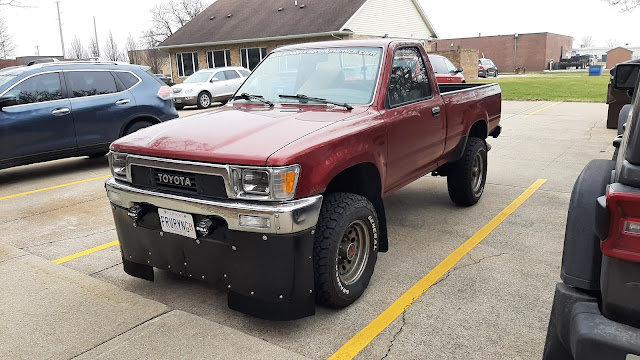Introduction: Part 3
My attitude hadn’t changed when, a few years later, I purchased the car I really wanted: a 2013 Prius. Here was a vehicle that had undergone significant aerodynamic development; Toyota advertised at the time that the third-generation Prius had spent more hours in a wind tunnel than any of the manufacturer’s other cars up to that point. Imagine my surprise, then, when I found that the forum members on Ecomodder thought there were significant problems with the car.
 |
| I don't even have a picture of it stock; I got right to work modifying it according to "conventional wisdom." |
Whole
threads were devoted to discussion of this “issue.” Tellingly, not once did
someone with a Prius run a simple test: tape yarn tufts to the rear window, go
for a drive, and observe whether they laid down in the same direction
(indicating attached flow) or flapped around in various directions (detached
flow). Not once!
 |
| Like this! |
That is
too bad, because had someone done that at the time, they would have observed
that the Prius has attached flow over the rear window. But this would have also
presented a challenge to the Template, and I wonder if the hesitation to test
and observe wasn’t based on equal parts belief in the Template and its
promoters as well as fear of disproving one of its accepted uses. After all, if
it turned out the Template couldn’t actually determine anything about flow
attachment or detachment over a real car, what else could be wrong with it? No
one wanted to go down that road.
I modified the Prius in the same pattern as I had the Civic before it: I bolted pizza pans to the wheel covers, replaced the external mirrors with internal ones, blocked part of the cooling air intake with foam pipe insulation, and installed lowering springs. I didn’t test anything; at the time, I still didn’t realize I could. I was very much operating, again, in a regime of “development by guess.”
 |
| A few months later. |
A funny thing happened this time, though: where the Civic had seen a dramatic increase in its fuel economy, the Prius with the same aerodynamic “improvements” (remember, I had no idea if any given modification was reducing drag, increasing it, or making no difference at all) returned barely better mileage than its EPA rating.
Disappointed, I decided to go all in on the Template. That’s how I ended up building this:
 |
| Yes, for real. |
That’s a fiberglass-over-foam board cargo box, tapered according to the Template. I built it before the annual Green Grand Prix, an SCCA-sanctioned fuel economy competition held at Watkins Glen every spring. That first year the weather was perfect, around 60° F and dry. The Prius returned 62.8 MPG.
For the
first time, I had a datum: there were other third-generation Prius in the
competition that year and my car did not get the best economy of all of
them. Disappointed that my Template tail had not worked its magic, I removed it
that summer and decided to see what would happen if I instead reduced weight
for next year’s Green Grand Prix.
 |
| The Prius in 2019, a couple hundred pounds lighter than the year before--verified on a truck scale. |
That year, the weather was not nearly as cooperative. The temperature was hovering around freezing, and as soon as we got on track it started sleeting. Soon we were driving through an inch of slush. Despite the awful conditions—I had to use the heater to keep the windshield from fogging, further increasing fuel consumption—the Prius achieved an official 59.2 MPG, not far off what it had done the year before in perfect conditions with that tail.
That was
the point at which I began to question the wisdom of the Template.




Comments
Post a Comment